Key Points:
- There are more than 50 species of snakes that call Florida home, and some get very big.
- African rock pythons, boa constrictors, and eastern diamondback rattlesnakes are among the biggest snake species in Florida.
- While the invasive species of Burmese pythons typically grow to about 16 feet on average, the largest recorded in Florida was close to 19 feet long.
Florida is one of the most diverse states with a diverse range of ecosystems that are home to many wonderful and unusual animals. From tropical regions, swamps, rivers, coastlines, and coral reefs, there is something for everyone. There are more than 50 species of snakes that call Florida home, and some of them can get pretty big. But, just how big are they? Join us as we discover the biggest snakes in Florida!

8. Eastern Rat Snake

The juvenile eastern rat snake has brown to black blotches on a gray background and a somewhat squared-off snout.
©Patrick K. Campbell/Shutterstock.com
Although eastern rat snakes are typically between 3 and 6 feet long, the longest recorded length was 7.5 feet. Eastern rat snakes in Florida are yellowish-orange with four darker stripes down their body. They live in hardwood forests, swamps, and farmland and are even found in residential areas where they sometimes climb into attics. They are extremely capable snakes as they can swim, climb, and burrow. Eastern rat snakes are nocturnal during the summer but are active during the day in spring and fall. However, they hibernate underground during the winter. These snakes are not venomous and feed on birds, frogs, rodents, and lizards.
7. Florida Pine Snake
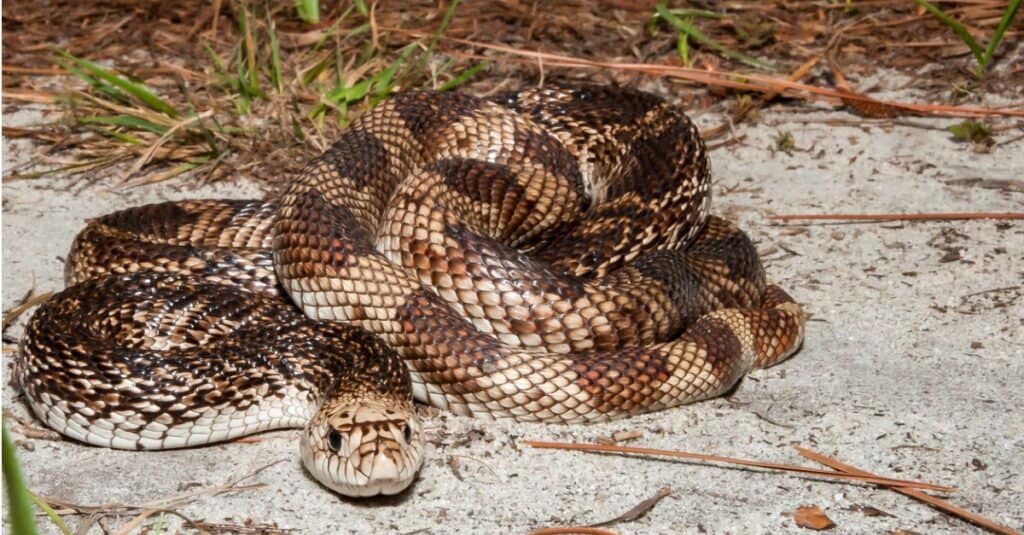
Though non-venomous, the Florida pine snake squeezes its prey to death.
©iStock.com/JasonOndreicka
Capable of reaching 7.5 feet long, Florida pine snakes are large, powerful reptiles. They are typically a light brown or gray color with black or brown markings. Florida pine snakes live in woodlands, prairies, and deserts at elevations of up to 9,000 feet. They prefer areas with loose, sandy soil to create burrows in which to lay their eggs. These snakes mainly eat rats, mice, moles, and voles. They are incredibly helpful as they regularly kill great numbers of rodents which are classed as pests. Sadly, the population of Florida pine snakes has been declining in recent years, and they have officially been a threatened species in Florida since 2017.
6. Eastern Indigo Snake
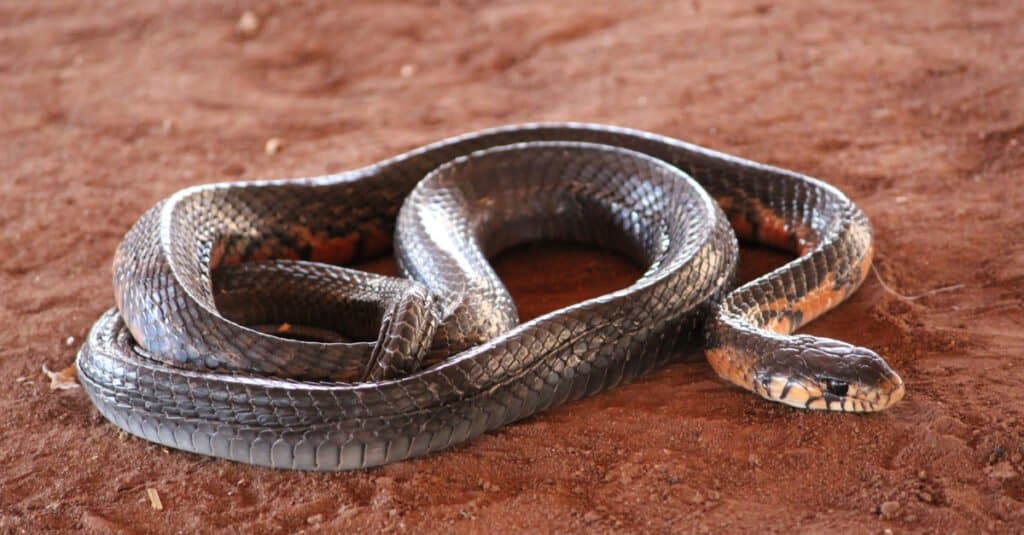
Eastern indigo snakes are glossy black and can grow to almost 8 feet long.
©Alan Jimenez G/Shutterstock.com
One of the biggest snakes in Florida that is native to the state is the eastern indigo snake, which can grow to almost 8 feet long. Eastern indigo snakes are a glossy black color and are particularly stunning as they often appear to be purple in sunlight. They prefer to live in hardwood hammocks, prairies, and sandy soil next to streams. Eastern indigo snakes spend much of the winter in tortoise burrows, often cohabiting with them. They are not venomous and feed on a variety of birds, lizards, frogs, toads, and any other small mammals that they can catch. The main predators of eastern indigo snakes are actually humans, as they are regularly killed accidentally by rattlesnake hunters. As a result, eastern indigo snakes are officially listed as a threatened species in Florida and Georgia.
5. Javan File Snake
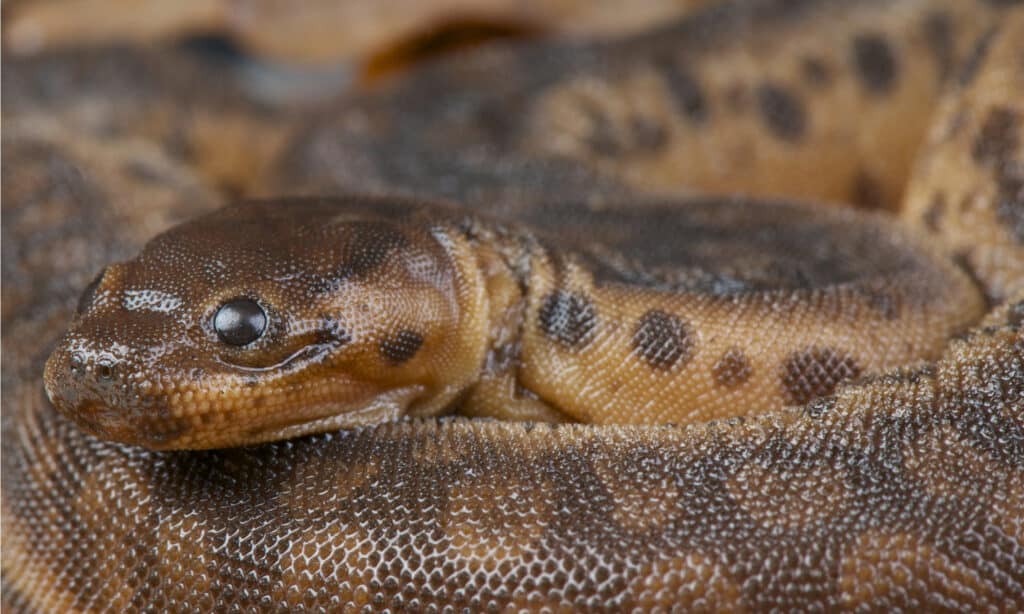
Javan file snakes have baggy skin, which almost looks too big for them.
©reptiles4all/Shutterstock.com
Also known as elephant trunk snakes, Javan file snakes can grow to lengths of 8 feet, with females being longer than males. They are dark brown with cream sides and bellies. The most unusual thing about these snakes is their skin, which is extremely baggy and almost seems to be too big for their bodies. Javan file snakes are native to Sumatra and were introduced to Florida in the 1970s. They are aquatic snakes and live in slow-moving water such as rivers, lakes, streams, and swamps. They spend the majority of their lives in the water and very rarely come onto land. Javan file snakes feed mainly on fish, frogs, toads, and salamanders.
4. Eastern Diamondback Rattlesnake

Eastern diamondback rattlesnakes have a pattern that often fades towards their tail.
©Chase D’animulls/Shutterstock.com
Despite typically being 3 to 6 feet long, with the largest recorded length of 8 feet 3 inches, eastern diamondback rattlesnakes are definitely one of the biggest snakes in Florida. They are the largest species of rattlesnake in the world and have heavy brownish bodies which are covered with large diamonds. The diamonds then change to dark bands on the tail, which end in a rattle. Eastern diamondback rattlesnakes live in pine woodland, scrubland, marshes, and cypress swamps. They are excellent swimmers and have been seen swimming between islands in the Florida Keys. Eastern diamondbacks are venomous snakes and can strike from distances of four feet. Their diet mainly consists of rabbits, rodents, and birds.
3. Boa Constrictor
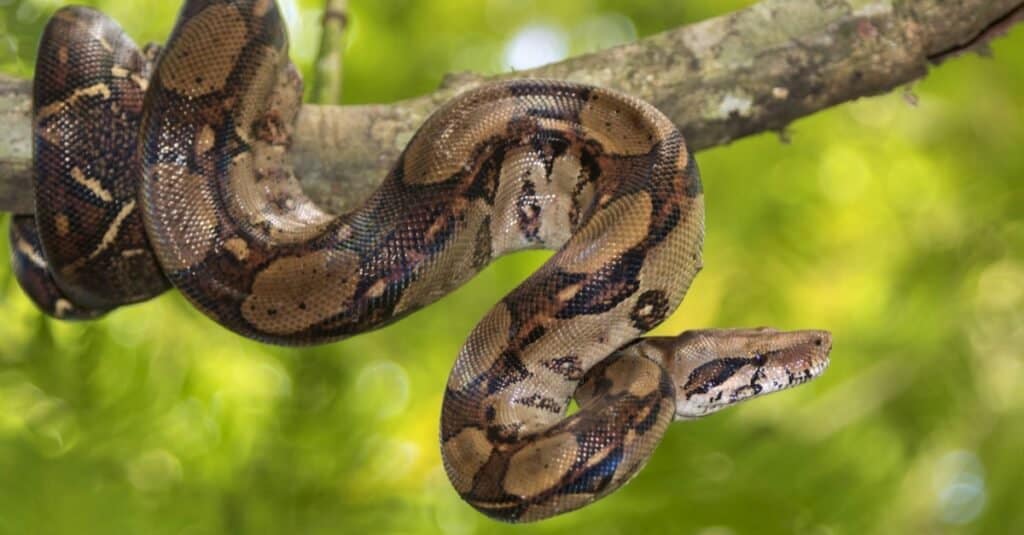
Boa constrictors are non-venomous snakes famous for their method of subduing prey by constriction.
©Natalia Kuzmina/Shutterstock.com
One of the best-known snakes is the boa constrictor, which reaches 10 to 15 feet long. Boa constrictors are not native to Florida and were introduced through the pet trade in the 1960s or 70s. They have thick bodies and are dark brown with an hourglass pattern. These snakes are one of the most adaptable snakes around and live in a range of habitats including swamps, forests, and alongside rivers and canals where there is plenty of cover from vegetation. They are excellent swimmers, and smaller specimens are capable climbers, so they can typically be found anywhere within their favored locations. Boa constrictors are most famous for their method of killing their prey by wrapping their bodies around them until they suffocate or have a cardiac arrest. Boa constrictors eat a mixture of birds and mammals and have very few predators.
2. African Rock Python
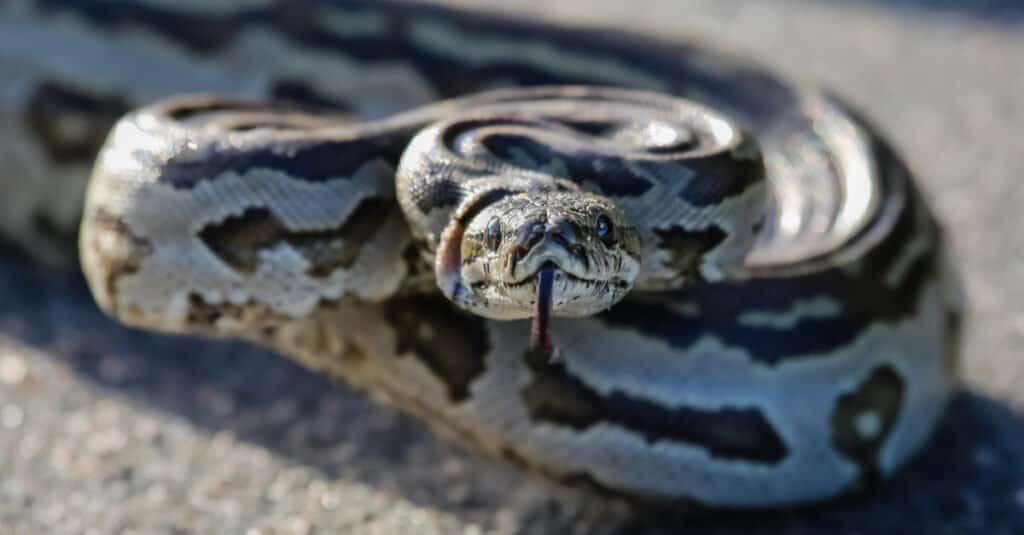
African rock pythons can reach 16 feet in length.
©Uwe Bergwitz/Shutterstock.com
The second-biggest snake in Florida is the African rock python, which is another non-native snake. African rock pythons are from sub-Saharan Africa and were introduced to Florida in 2002. These snakes are typically between 10 and 16 feet long and have thick, heavy bodies, which are brown with dark blotches that are bordered with black. They are extremely adaptable snakes and live in many different habitats. However, their preferred habitats in Florida are sawgrass prairies, wetlands, and alongside lakes and rivers. African rock pythons are particularly well established in South Florida and in the Florida Everglades. They are powerful constrictors and eat anything they can catch, whatever the size. Due to their incredible bulk and strength, the only predators of African rock pythons are alligators.
1. Burmese Python
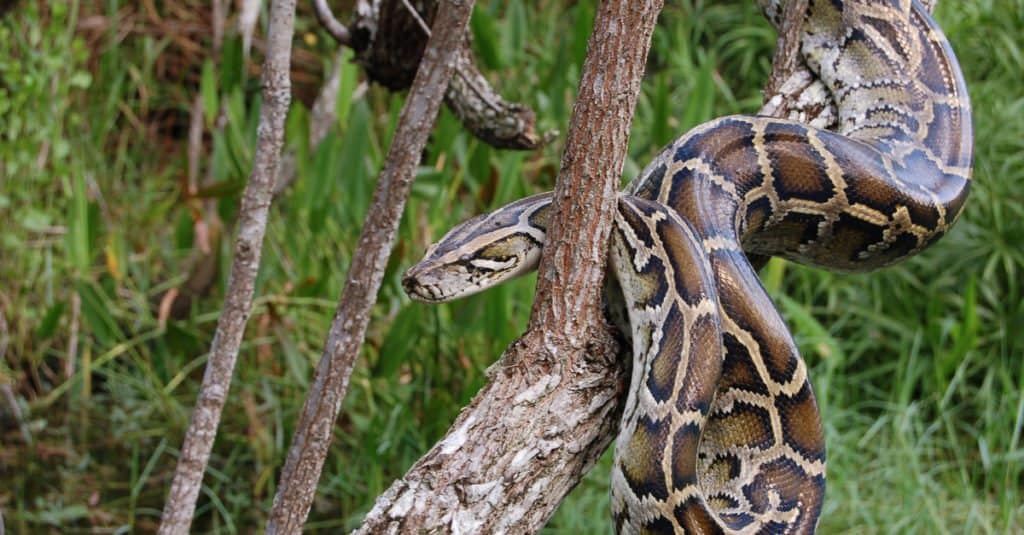
The
Burmese
python is one of the largest snake species in Florida.
©Heiko Kiera/Shutterstock.com
The biggest snake in Florida is the Burmese python. Although most Burmese pythons only reach around 16 feet, the largest ever recorded in Florida was almost a whopping 19 feet long! This record was set in 2020 when an 18 feet 9 inches long Burmese python was captured in the Florida Everglades. This massive snake surpassed the previous record of 18 feet 8 inches, recorded in 2013. Burmese pythons are not native to Florida but from southeast Asia and were introduced in 1979 through the pet trade. Burmese pythons are dark brown with dark blotches down their sides. They typically live near permanent water sources, and one of their favored habitats is wetland regions such as the Florida Everglades.
Due to their massive size, Burmese pythons have quickly become the most invasive snakes in Florida. This is because they eat pretty much anything they can catch, whether it’s birds, mammals, or amphibians. These snakes prey on many native species, including some which are endangered — such as Key Largo woodrats — which has led to a significant decline in their numbers. Additionally, other native species have to compete against these massive snakes for food and habitat space. Native animals such as rabbits, foxes, and bobcats simply can’t compete against Burmese pythons, which means they are unable to maintain their populations.
Summary of the Biggest Snakes in Florida
Here’s a recap of the eight large snake species found in Florida that we took a look at.
| Number | Snake | Length |
|---|---|---|
| 1 | Burmese Python | Longest recorded was 19 ft |
| 2 | African Rock Python | 10-16 ft |
| 3 | Boa Constrictor | 10-15 ft |
| 4 | Eastern Diamondback Rattlesnake | Longest recorded was 8.3 ft |
| 5 | Javan File Snake | Up to 8 ft; females longer than males |
| 6 | Eastern Indigo Snake | Up to 8 ft |
| 7 | Florida Pine Snake | Up to 7.5 ft |
| 8 | Eastern Rat Snake | Longest recorded was 7.5 ft |
Other Big Animals Found In Florida

One of the only known birthing areas of North Atlantic right whales is off the Florida coast.
©iStock.com/6381380
One of the world’s largest whales is also one of the most endangered ones: the North Atlantic right whale. With only an estimated 300 to 400 individuals remaining, this enormous baleen mammal is one of the rarest of its species. Their only remaining habitat is along the eastern United States and Atlantic Canada and it is believed that one of their only known birthing areas is off the Florida coast, which has been designated as a right whale critical habitat by the NOAA Fisheries. This whale can reach up to 55 feet, with weights up to 70 tons, and may be seen off this coast between November and April.
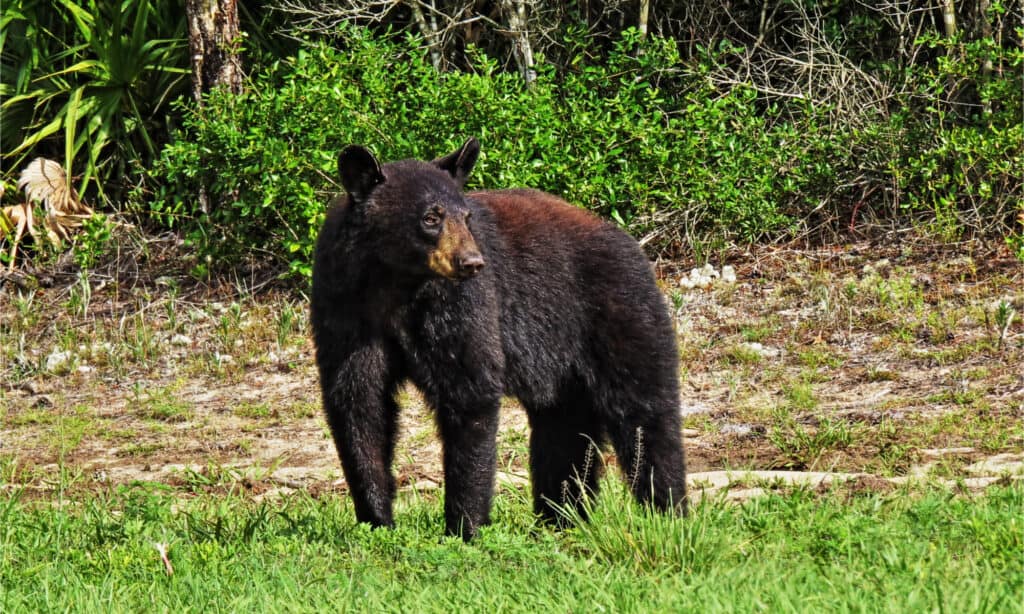
The Florida black bear, which primarily has a vegetarian diet, doesn’t have much of a fear of humans.
©Roger Epps/Shutterstock.com
The Florida black bear, once a common sight in the sunshine state, is now endangered and very rarely seen. The average adult male bear weighs about 300 pounds and lives on a mostly vegetarian diet, with meat only comprising 5% of this. It is illegal to kill, or even injure this mammal but unfortunately, these bears don’t have much of a fear of humans and are conditioned to find food in areas not native to them, like recreational areas, and when they wander into residential areas they may be injured.
The photo featured at the top of this post is © Heiko Kiera/Shutterstock.com
Discover the "Monster" Snake 5X Bigger than an Anaconda
Every day A-Z Animals sends out some of the most incredible facts in the world from our free newsletter. Want to discover the 10 most beautiful snakes in the world, a "snake island" where you're never more than 3 feet from danger, or a "monster" snake 5X larger than an anaconda? Then sign up right now and you'll start receiving our daily newsletter absolutely free.
Thank you for reading! Have some feedback for us? Contact the AZ Animals editorial team.







